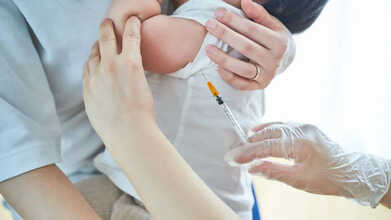- Health Conditions A-Z
- Health & Wellness
- Nutrition
- Fitness
- Health News
- Ayurveda
- Videos
- Medicine A-Z
- Parenting
Heart Diseases Remain Top Cause Of Death In US: Read Full Report

Deaths (Credit: Canva)
Heart disease and cancer maintained their grim distinction as the leading causes of death in the United States in 2023, together accounting for 40% of all fatalities. As per the latest data revealed by the CDC, the overall death rate from these conditions saw modest declines. However. COVID-19 dropped significantly to become the 10th leading cause of death, indicating that its impact had reduced.
Cardiovascular disease remained the leading cause of death among the people. According to the latest report by the National Center for Health Statistics, deaths from heart disease were recorded at 162.1 in 2023. This was a slight decline from 167.2 per 100,000 people in 2022. Cancer-related fatalities also declined marginally from 142.3 to 141.8 per 100,000. Despite these reductions, the two conditions remain at the top of the list.
Coronavirus, which held the fourth spot in 2022 with 44.5 deaths per 100,000 people, dropped significantly to 11.9 in 2023. This sharp decline reflects increased immunity, widespread vaccination efforts, and advancements in treatment protocols. However, the virus still claimed enough lives to remain among the top 10 causes of death.
Accidental deaths, the third leading cause, showed a slight reduction, decreasing from 64.0 per 100,000 in 2022 to 62.3 in 2023. Stroke-related deaths also dipped marginally, from 39.5 to 39 per 100,000, while chronic lower respiratory diseases declined from 34.3 to 33.4. These changes, though minor, suggest ongoing efforts to address risk factors in the healthcare system.
Other conditions that showed decline were Alzheimer's disease, diabetes, kidney disease, and chronic liver disease. Deaths from Alzheimer's, which is a neurodegenerative disease, fell from 28.9 per 100,000 in 2022 to 27.7 in 2023. Diabetes-related fatalities decreased from 24.1 to 22.4 per 100,000. Meanwhile, kidney disease and chronic liver disease dropped to 13.1 and 13.0 per 100,000, respectively, from 13.8 each in the prior year.
ALSO READ: Why Is Snow Shoveling Risky For Your Heart?
A Shift In Focus
The significant drop in COVID-19 deaths marks a shift in public health priorities as the nation continues to recover from the pandemic's acute phases. While efforts to curb COVID-19 have yielded promising results, the data reaffirms the persistent burden of chronic illnesses like heart disease, cancer, and diabetes on the healthcare system.This report comes as the US and other Western countries are witnessing extremely cold weather. Recent research has found that shovelling snow, which may seem like a routine winter task, poses significant health risks, particularly for the heart. The cold temperatures combined with physical exertion can strain the cardiovascular system, increasing the likelihood of heart attacks. A study by the American Heart Association (AHA) linked heavy snowfall (7–8 inches) to a 16% increase in heart attack hospitalizations among men and a 34% rise in fatal heart attacks. Moreover, these constricted blood vessels also contribute to high blood pressure, exacerbating the risks of brain stroke.
ALSO READ: France Bans Sale of Eight Cold Medicines Due to Health Risks
Ayush Mark Explained: What Is This New Global Standard Label For Traditional Medicine?

Credits: Canva
Prime Minister Narendra Modi unveiled the Ayush Mark at the Second WHO Global Summit on Traditional Medicine on Friday. The Ayush Mark is envisioned as a global standard for quality Ayush products and services. The WHO Global Summit on Traditional Medicine was held at Bharat Mandapam from December 17 to December 19, 2025, with this year’s theme, “Restoring balance: The science and practice of health and well-being.” Speaking at the closing ceremony, PM Modi highlighted India’s rising leadership in promoting traditional medicine as an evidence-based, integrated, and people-focused part of global health systems.
Alongside the Ayush Mark, PM Modi also introduced the My Ayush Integrated Services Portal (MAISP), the central digital platform of the Ayush Grid, released a commemorative Ashwagandha postal stamp, the WHO technical report on Yoga training, and the book “From Roots to Global Reach: 11 Years of Transformation in Ayush.” He also presented the Prime Minister’s Awards for Outstanding Contribution to the Promotion and Development of Yoga, recognizing both national and international individuals and organizations for their exceptional service.
Speaking at the event, he said, “Over the past three days, experts from across the world in traditional medicine have held meaningful discussions here. I am glad India is providing a strong platform for this, and the WHO has actively participated. It is our good fortune and a matter of pride that the WHO Global Centre for Traditional Medicine has been established in Jamnagar, India. The world entrusted us with this responsibility with great confidence at the first Traditional Medicine Summit.”
What Is The Ayush Mark?
The Ayush Mark is a label issued by the Ministry of Ayush for Ayurveda, Yoga and Naturopathy, Siddha, Unani, and Homoeopathy products and services. The Ayush Mark Certification Scheme has been run by the Quality Council of India (QCI) since 2009.
Products and services carrying the Ayush Mark follow quality manufacturing practices, use standard raw materials, and undergo safety testing. The Ayush Mark and its two previous certification levels have existed for several years. The new label builds on them and aims to set a global benchmark for traditional medicine products and services. Earlier certifications included the Ayush Standard Mark and the Ayush Premium Mark.
The Ayush Standard Mark follows Good Manufacturing Practices (GMP) for Ayurvedic, Siddha, and Unani medicines under Schedule T of the Drugs and Cosmetic Rules, 1945. The Ayush Premium Mark is aligned with WHO GMP guidelines for herbal medicines.
Dr Tedros Adhanom Ghebreyesus, WHO Director-General, also attended the WHO Global Summit on Traditional Medicine. He praised PM Modi for elevating traditional medicine to a global platform. Dr Tedros commended India for turning vision into action, calling the country a global leader in transforming traditional medicine from heritage to evidence-informed practice. He highlighted landmark initiatives like the establishment of the Ministry of Ayush and the WHO Global Centre for Traditional Medicine in Jamnagar, noting these efforts have strengthened the integration of traditional medicine into health systems, research, and policy, supporting universal health coverage and sustainable development worldwide.
Global Recognition and Impact of Ayush Mark
The Ayush Mark is not just a certification but a step toward placing Indian traditional medicine on the world stage. By setting internationally recognized quality benchmarks, it aims to boost confidence among global consumers and practitioners, encouraging the adoption of Ayurveda, Yoga, Naturopathy, Siddha, Unani, and Homoeopathy products and services worldwide. This initiative reinforces India’s role in shaping evidence-based, safe, and sustainable traditional medicine practices across borders.
What Is Denmark’s Childhood Vaccination Schedule That RFK Jr. Is Considering For The U.S.?

Credits: Canva
The Trump administration is reportedly preparing to announce changes to the childhood immunisation schedule early next year, with a proposal that would recommend fewer vaccines and bring U.S. policy closer to Denmark’s model. A source familiar with the discussions told NewsNation correspondent Libbey Dean that the revised schedule, expected next year, would involve fewer shots and would be “more in line with Denmark’s vaccination schedule,” according to The Hill. This has raised an important question: what does Denmark’s vaccine schedule look like, and is it realistic for the U.S. to follow it?
Denmark Vaccine Schedule: What Is It?
Denmark runs a clearly defined childhood vaccination programme that is free and voluntary, aimed at protecting children from serious infectious diseases. Infants are given combination vaccines that cover diphtheria, tetanus, whooping cough, polio, and Haemophilus influenzae type b, along with the pneumococcal vaccine, at 3, 5, and 12 months. Children receive their first dose of the measles, mumps, and rubella (MMR) vaccine at 15 months, with a second dose at 4 years.
A booster shot for diphtheria, tetanus, whooping cough, and polio is administered at 5 years. Around the age of 12, both boys and girls are offered the HPV vaccine to reduce the risk of cancers linked to the virus. Vaccines for chickenpox, rotavirus, hepatitis A, or meningococcal disease are not routinely included in Denmark’s standard schedule, according to official guidance from the Danish Health Authority’s Childhood Vaccination Programme.
RFK Jr. Is Considering Denmark Vaccine Schedule For US
Reports suggest that the Department of Health and Human Services (HHS) is exploring additional changes to federal childhood vaccine recommendations, with a focus on aligning them more closely with those followed by other developed nations, especially Denmark, as per The Washington Post. This discussion comes after a meeting earlier this month of the CDC’s Advisory Committee on Immunization Practices (ACIP), where childhood vaccine schedules in the U.S. and Denmark were reviewed and adjustments to the U.S. schedule were made. It was followed by a memorandum from President Trump directing HHS to begin a “process to align U.S. core childhood vaccine recommendations with best practices from peer, developed countries.”
Denmark Vaccine Schedule: What Happens If the US Adopts It?
If the U.S. were to adopt Denmark’s schedule in full, it would result in fewer vaccines being recommended for children up to age 18. When comparing vaccines that are universally advised in both countries, Denmark’s programme covers protection against 10 diseases, while the U.S. schedule includes vaccines for 16 diseases, following the removal of hepatitis B from universal recommendations. The additional vaccines recommended in the U.S. address respiratory syncytial virus (RSV), rotavirus, varicella, hepatitis A, and meningococcal disease. Although the U.S. advises more childhood vaccines than many comparable countries, Denmark stands out for recommending fewer than most. Data from the European Centre for Disease Prevention and Control (ECDC) vaccine scheduler shows that none of the other 29 ECDC member countries limits its routine childhood schedule to just 10 diseases. Several countries, including Germany, Greece, Ireland, Italy, and Poland, recommend vaccines against 15 or more diseases, while Austria’s schedule covers 17 diseases, which is even more than the U.S. currently recommends.
Every country follows its own process when setting vaccine recommendations, shaped by its specific circumstances. Childhood immunisation schedules are built over years by reviewing available evidence and weighing factors such as healthcare systems, insurance coverage, public health infrastructure, and national priorities. This explains why vaccine schedules vary across countries, and so far, no developed nation has based its decisions solely on what another “peer” country does.
Importantly, Denmark’s approach is not based on a different interpretation of vaccine science or effectiveness. Instead, Danish health authorities prioritise recommending vaccines that significantly lower the risk of death or serious illness in children. For instance, while rotavirus infections do occur among children in Denmark, they rarely result in death or long-term harm in a setting with universal healthcare access, strong medical systems, and lower inequality than in the U.S. By contrast, neighbouring countries such as Norway and Finland do include the rotavirus vaccine in their routine schedules, as does the U.S., where before the vaccine was introduced, rotavirus caused an estimated 2.7 million infections each year, leading to 55,000 to 70,000 hospitalisations and 20 to 60 deaths among children under five.
'No Direct Link Between Lung Disease And Air Pollution,' Says Minister; But Studies Say Something Else

Credits: Wikimedia Commons and AQI.in
Delhi yet again woke up to a thick smog blanketed Saturday morning. The AQI stood at 380 for the city, which puts it under the 'very poor' category, as of 7am, according to the Central Pollution Control Board (CPCB). Several parts of the city also recorded with in the 'severe' limits of air pollution, with multiple stations recording AQI above 400. These areas include Anand Vihar and Sarai Kale Khan recorded 428 AQI, ITO recorded 429, Akshardham recorded 420, Ashok Vihar recorded 407, and Rao Tularam Marg recorded 403.
While GRAP Stage IV is enforced in the capital to combat the pollution problem, amid this, Minister of State for Environment and Climate Change Kriti Vardhan Singh told the Rajya Sabha on Thursday that there is no direct correlation between higher Air Quality Index or AQI levels and lung diseases. He said that there is no "conclusive data" to establish such a link. However, he did say that air pollution is one of the "triggering factors" for respiratory ailments and associated diseases.
What Do Doctors And Research Say On The Link of Lung Diseases And Air Pollution
"Lung cancer is no longer a smoker’s but a breather’s disease," said Dr Arvind Kumar, chairman, Lung Transplant, Chest Surgery and Oncosurgery at Medanta, Gurugram, as reported by The Indian Express. He treated a 31-year-old patient from Ghaziabad with lung cancer, who had never smoked in her life.
"Younger non-smokers are being diagnosed. And there are as many women as men. This indicates that lung cancer is no longer a smoker’s but a breather’s disease. While we talk of particulate matter, the ambient air in the urban environment is full of carcinogenic gases. And this is emerging as a real threat to everybody," the doctor said.
Dr Shivanshu Raj Goyal, a pulmonologist and Associate Director Pulmonary Medicine at MAX Healthcare in Gurugram and Delhi, in an Instagram video said that breathing this toxic air is equivalent to smoking 20 cigarettes in a day. The doctor starts his video with a rather strong statement, "At present, no one in Delhi-NCR is a non-smoker."
The doctor also states that on an average, a person breathes around 20,000 times in a day, so it means we are inhaling the toxic air at least 20,000 times a day.
As per a 2017 study titled Pulmonary Health Effects of Air Pollution, it is clear that lung cancer could be exacerbated due to exposure to a variety of environmental air pollutants with greatest effects due to particulate matter (PM), ozone, and nitrogen oxides.
As per Action on Smoking and Health (ASH), a cigarette contains nicotine, and tar, which is composed of chemicals like benzene, benzopyrene, and the gas includes carbon monoxide, ammonia, dimethyl nitrosamine, cadmium, formaldehyde, hydrogen cyanide and acrolein. Some of these marked irritant properties are also carcinogen, meaning, it can cause cancer.
Whereas Air Pollution contains pollutants like particulate matter PM 10 and PM 2.5, ozone, nitrogen dioxide, carbon monoxide, cadmium and sulfur dioxide. Air pollution, which is often a byproduct of combustion or released from vehicle exhaust also contain formaldehyde, benzopyrene, and benzene. As per the World Health Organization (WHO), the pollutants contain carcinogens, and the outdoor air pollution is in fact classified as Group 1 carcinogen.
Read: Breathing Delhi's Toxic Air Is Like Smoking 20 Cigarettes A Day
Common Chemicals We Inhale When We Breathe Delhi's Toxic Air And When We Smoke A Cigarette
Carbon Monoxide: a poisonous, flammable gas that is colorless, odorless, tasteless, and slightly less dense than air.
Benzene: a colorless and highly flammable liquid with a sweet smell, and is partially responsible for the aroma of gasoline.
Cadmium: a soft, silvery-white metal (atomic number 48) that is toxic and naturally found in the environment, but human activities have increased its levels. It is used in products like batteries, pigments, and coatings, and exposure can occur through tobacco smoke, contaminated food, and occupational inhalation. Cadmium is a known human carcinogen that can damage the kidneys and bones.
Formaldehyde: a colorless, flammable gas with a strong odor, whose exposure could cause cancer.
Benzopyrene: a group of organic compounds known as polycyclic aromatic hydrocarbons. It is a colorless crystalline solid found in sources like cigarette smoke, coal tar and is a known carcinogen that can cause cancer and other health problems like skin rashes and bronchitis, and exposure requires medical attention for any symptoms.
© 2024 Bennett, Coleman & Company Limited

